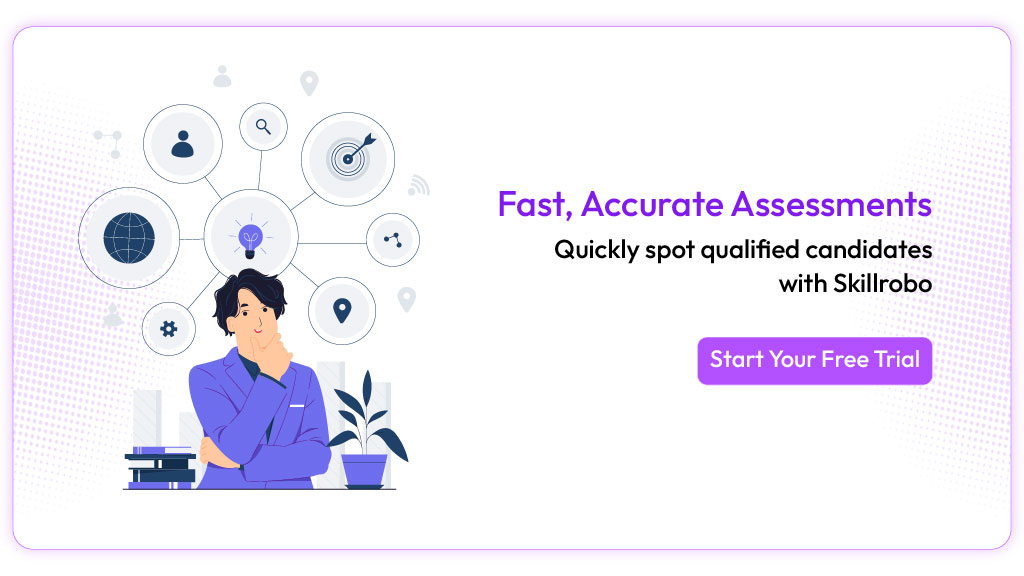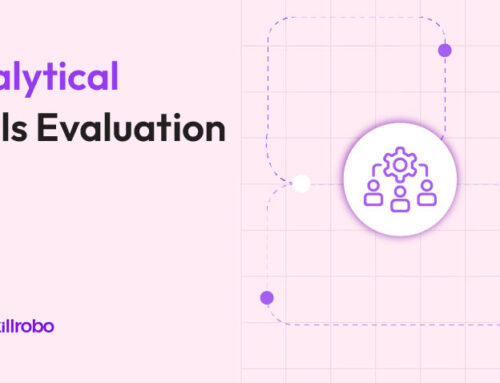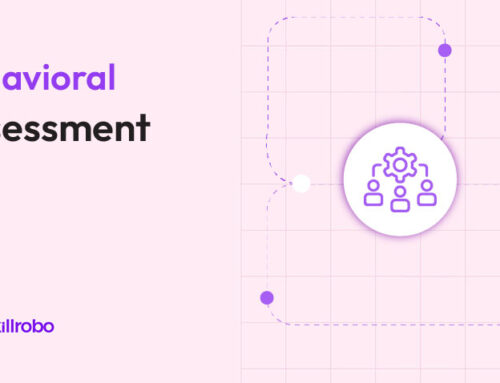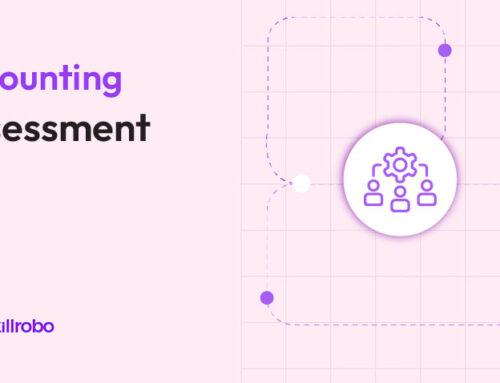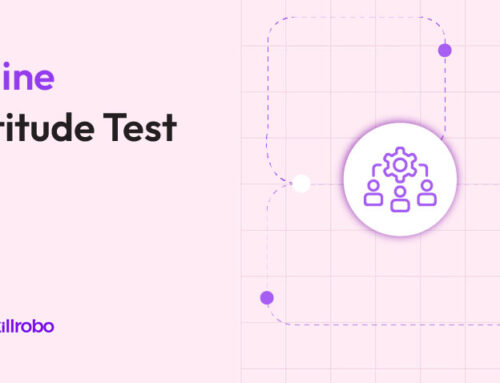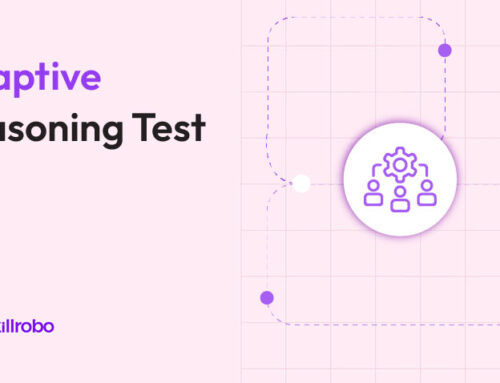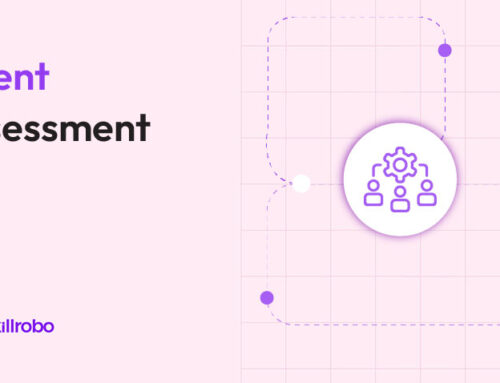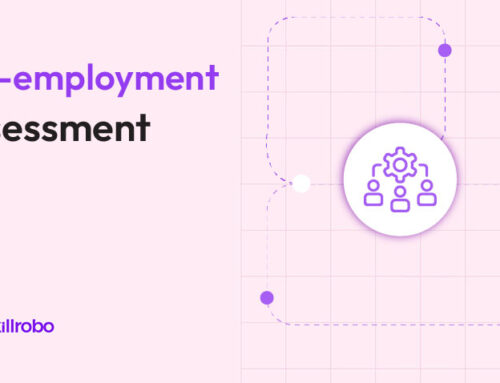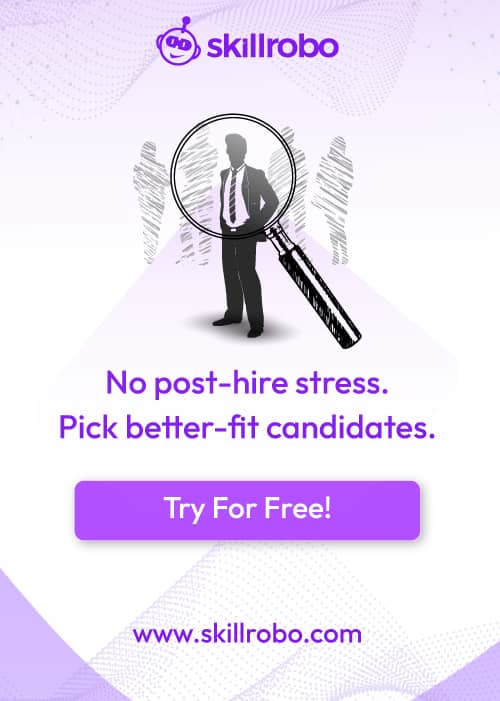Table of Contents
- Key Takeaways
- Why Skills Matrices Matter More Than Ever
- What Is a Skills Matrix?
- Skill Matrix vs. Skill Will Matrix
- Steps to Create a Skills Matrix
- Skills Matrix Template: What to Include
- Skills Matrix Example (Basic Format)
- Benefits of a Skills Matrix
- Digital Tools for Skills Matrix Management
- Common Mistakes to Avoid When Using a Skills Matrix
- How Skillrobo Supports Skills Matrix Creation and Assessment
- Final Thoughts: Make Skills Your Superpower
- Frequently Asked Questions
Related articles
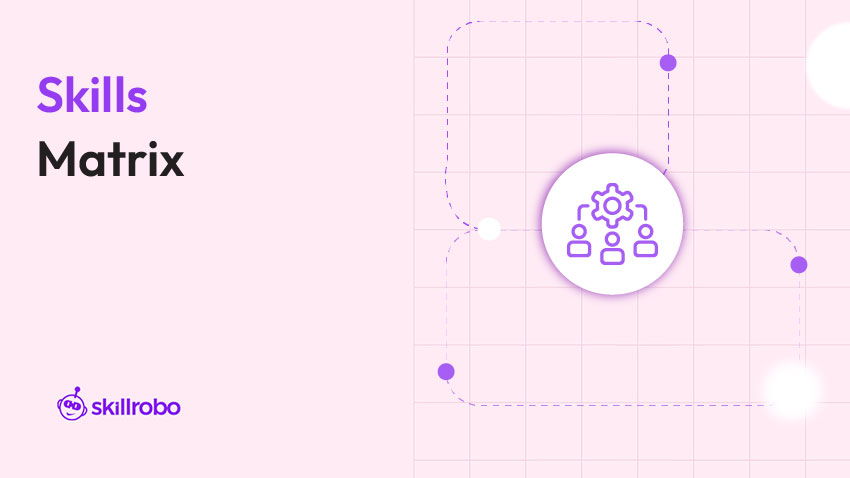
Key Takeaways
- A skills matrix offers a visual overview of employee competencies across roles, departments, and teams.
- The Skill Will Matrix helps managers evaluate both capability and motivation for performance coaching.
- Using a structured skills matrix template simplifies team planning, training, and succession management.
- A well-designed skill set matrix enhances transparency, improves project staffing, and accelerates skill development initiatives.
Why Skills Matrices Matter More Than Ever
With rapid digital transformation and talent mobility on the rise, knowing who can do what—and how well—is essential. Organizations can’t afford to rely on outdated org charts or job titles. They need real-time visibility into their workforce capabilities. That’s where the skills matrix becomes a strategic tool.
Tools like customized employee skill assessment strategies can support this process by aligning individual capabilities with business needs, making the matrix even more actionable. A skills matrix enables HR teams and managers to visualize existing competencies, identify skill gaps, and allocate resources effectively. Whether you’re building agile teams, planning L&D paths, or preparing for succession, this matrix gives you clarity, speed, and confidence in decision-making.
In this blog, we’ll explore what a skills matrix is, how it differs from other tools like the Skill Will Matrix, how to create one, and how to use it for maximum business impact.
What Is a Skills Matrix?
A skills matrix is a visual management tool used to map employee skills against required competencies for specific roles or projects. It shows who on your team has which skill, how proficient they are, and where gaps exist.
Typically, it’s organized in a grid format—employees on one axis, and required skills on the other. Each cell indicates the level of proficiency using a numeric scale or color code. It may also include certification status, years of experience, or interest in development.
A skill set matrix is especially useful in cross-functional teams, helping leaders quickly see which employees are ready to take on new challenges and who might need upskilling. Tools like online employee skill assessment tools can enhance the accuracy of your matrix by providing objective performance data.
Skill Matrix vs. Skill Will Matrix
While a skills matrix provides a clear snapshot of employee abilities and proficiency levels, the Skill Will Matrix goes one step further by evaluating motivation, a critical yet often overlooked factor in performance and growth.
In talent management, it’s not enough to know what someone can do. You also need to understand what they’re willing to do. That’s where the skill-will model becomes incredibly useful, especially for coaching, leadership development, and team alignment.
Here’s how the Skill Will Matrix typically breaks down:
1. High Skill, High Will
These are your top performers. They not only have the required competencies but are also enthusiastic and driven. They’re prime candidates for leadership roles, stretch assignments, and cross-functional projects.
2. High Skill, Low Will
These employees are capable but lack engagement or motivation. They might be bored, misaligned with company values, or unclear about their career path. Managers should focus on uncovering the root cause and finding ways to re-engage them.
3. Low Skill, High Will
This group is eager, committed, and willing to grow, but currently lacks the technical or functional expertise. With structured learning and mentorship, they often become high performers over time.
4. Low Skill, Low Will
These individuals may be struggling in both capability and attitude. They require close management attention to determine whether coaching, reskilling, or role reassignment is the right path.
By combining the skill matrix and the skill will matrix, organizations gain a fuller view of talent potential. This dual model helps tailor development strategies, inform training investments, and guide people’s decisions with empathy and clarity.
Whether you’re building teams, leading performance reviews, or planning internal mobility, using both tools ensures you’re not just managing performance but enabling growth and long-term success.
Steps to Create a Skills Matrix
Creating a skills matrix doesn’t have to be time-consuming or complicated. When structured properly, it becomes a powerful decision-making tool that supports everything from hiring and training to succession planning and internal mobility. Whether you’re using a spreadsheet or an advanced HR platform, the process follows a few core steps that help ensure accuracy and usability.
Follow this practical roadmap to build your matrix:
Step 1: Define the Purpose
Start by understanding what you want to achieve. Are you building teams for a project, planning training programs, or preparing for role transitions? Your objective will shape the format, depth, and frequency of the audit. For instance, organizations often use a skills assessment strategy to tailor the matrix according to workforce planning or development goals.
Step 2: List Required Skills
Break down each role or project into a set of key competencies. Include a mix of technical, soft, and leadership skills relevant to each function. This step creates the foundation for accurate capability mapping and helps avoid generic or irrelevant data.
Step 3: Add Employees
Next, add the team members you want to evaluate. You can do this by department, job function, or project team. Be sure to align each employee to the roles they currently hold—or roles they may grow into.
Step 4: Rate Skill Proficiency
Assess each employee’s skill level using a standard format. Many companies use a 1–5 numeric scale or a traffic-light color system (Red = Beginner, Yellow = Intermediate, Green = Expert). Some platforms also allow for dual scoring through both self-assessments and manager input, which enhances accuracy. To streamline this, tools like online employee skill assessments can automate scoring and maintain consistency across departments.
Step 5: Analyze and Act
Use your completed matrix to spot gaps, training opportunities, and succession paths. Highlight employees ready for upskilling or lateral movement. This is where your matrix becomes a living, evolving resource that drives strategic HR initiatives—not just a static snapshot.
Skills Matrix Template: What to Include
A well-structured skills matrix template serves as the foundation for accurate workforce evaluation and strategic planning. Whether you’re building your first matrix or refining an existing one, including the right elements ensures that your insights are actionable and aligned with business goals.
Here’s what every effective skill matrix format should include:
- Employee names and roles
- List of relevant skills
- Proficiency rating scale (numeric or color-coded)
- Optional: last updated date, certifications, or interest in learning
Whether you build your matrix in Excel, Google Sheets, or a dedicated platform, the core goal is the same: clarity, consistency, and alignment with business needs. A good template isn’t just about collecting data—it’s about turning that data into strategic talent insight.
Skills Matrix Example (Basic Format)
| Employee | Role | Project Mgmt | Excel | Leadership | Certifications |
|---|---|---|---|---|---|
| Jane Smith | Team Lead | 4 | 3 | 4 | PMP |
| John Doe | Data Analyst | 2 | 5 | 2 | Excel Specialist |
| Priya Patel | Project Manager | 5 | 4 | 5 | Agile Certified |
| Miguel Torres | HR Specialist | 3 | 3 | 3 | HRBP Certification |
Proficiency Rating
1 = Beginner
2 = Basic knowledge
3 = Intermediate
4 = Advanced
5 = Expert
This version keeps the matrix lean and readable while highlighting three essential competencies and certifications that matter for workforce planning.
Benefits of a Skills Matrix
A well-implemented skills matrix offers more than just a snapshot of employee capabilities—it becomes a strategic asset for HR, L&D, and leadership teams alike. Here’s how it delivers measurable value across your organization:
1. Better Resource Allocation
Rather than relying on job titles or guesswork, leaders can assign tasks and projects based on actual, verified skill data. This ensures optimal productivity and more effective use of internal resources. It’s particularly useful when combined with talent assessment tools with ATS integration, which ensure a seamless flow of skill data across hiring and team deployment.
2. Faster Training Decisions
Once gaps are visible, L&D teams can act swiftly, developing role-specific learning interventions that address exactly what’s needed. No more generalized training programs or wasted budgets.
3. Improved Workforce Agility
When departments need to pivot or scale quickly, a skills matrix makes it easy to reorganize teams, redeploy talent, and maintain momentum. This level of responsiveness is essential in dynamic industries or during digital transformation.
4. Transparent Career Paths
Employees gain visibility into how their current skill set aligns with organizational needs and what they need to improve. This clarity fuels engagement, self-directed development, and long-term retention.
5. Succession Planning
By tracking skill depth across key roles, HR can identify rising stars and build leadership pipelines. When paired with behavioral aptitude assessments in hiring, this data can also inform future-fit leadership selections based on both ability and mindset.
Digital Tools for Skills Matrix Management
While traditional spreadsheets may be sufficient for smaller teams, they quickly become difficult to maintain as organizations grow. Manual updates, version control issues, and a lack of integration with other systems can lead to fragmented or outdated insights. That’s why many companies are adopting modern skills matrix software to centralize, automate, and scale their workforce competency tracking.
These tools not only simplify the skills mapping process but also offer real-time visibility into gaps, strengths, and team readiness. Advanced platforms provide analytics that inform everything from learning pathways to succession planning, turning your skills matrix into a living, strategic resource.
When selecting a digital solution, look for features such as:
- Role-based skill tracking to map specific competencies by job function or project
- Self and peer reviews to collect feedback from multiple sources and reduce bias
- Real-time dashboard reporting for on-demand insights into team capabilities
- Skill development planning to connect audit data directly to learning interventions
- Integration with LMS or HRIS systems for seamless updates and automation
Platforms that support cloud-based talent assessments for global teams can enhance this process further, especially in remote or distributed work environments where consistency and accuracy are critical.
Common Mistakes to Avoid When Using a Skills Matrix
A skills matrix is a powerful tool—but only if used correctly. Many organizations dive in with good intentions, only to run into avoidable pitfalls that compromise data accuracy, engagement, or decision-making. Here are the most common mistakes to steer clear of:
1. Treating It as a One-Time Task
A skills matrix should evolve with your team. Static data becomes outdated quickly, especially in fast-paced environments. Regular updates—quarterly or biannually—ensure your matrix reflects current realities.
2. Overcomplicating the Format
While it’s tempting to add dozens of skills and multiple rating criteria, an overly complex matrix becomes difficult to interpret and maintain. Focus on the skills that directly impact business outcomes.
3. Ignoring Employee Input
A top-down approach limits accuracy and engagement. Including self-evaluations and peer reviews as part of your skill assessment process adds valuable context and encourages buy-in from employees.
4. Lacking Clear Rating Guidelines
Without a standardized rating scale (and clear definitions), managers and employees may interpret proficiency levels differently. This inconsistency weakens the value of the matrix.
5. Not Acting on the Insights
The most common mistake? Collecting data and doing nothing with it. Use matrix insights to guide training, promotions, role changes, and workforce planning. Otherwise, it’s just a table, not a tool.
How Skillrobo Supports Skills Matrix Creation and Assessment
If you’re looking to move beyond spreadsheets and manage your skills matrix with precision, Skillrobo offers a robust, AI-powered platform that simplifies and scales the entire process. From automated evaluations to real-time reporting, Skillrobo helps HR teams track competencies, identify gaps, and align workforce capabilities with strategic goals.
Here’s how Skillrobo enhances skills matrix management:
- Automated Skill Assessments – Skillrobo enables you to conduct objective, role-based skill assessments across technical, soft, and behavioral domains—providing reliable data to populate your matrix.
- Customizable Templates – Build role-specific or department-wide skills matrices using prebuilt templates, reducing setup time and improving standardization.
- Self and Manager Reviews – Collect ratings from both employees and supervisors to get a 360° view of current skill levels and development needs.
- Dynamic Dashboards – Visualize skill gaps, team strengths, and training priorities through real-time dashboards that update as new data is added.
- Integration Capabilities – Seamlessly connect Skillrobo with your HRIS or LMS to tie assessment results directly to development plans or onboarding processes.
With Skillrobo, your skills matrix becomes more than a static chart—it transforms into a dynamic workforce planning tool that evolves with your business.
Final Thoughts: Make Skills Your Superpower
A skills matrix turns invisible capabilities into visible strategy. Whether you’re building a training program, staffing a project, or planning succession, it gives you clarity at every level. It’s not just an HR tool—it’s a business tool. One that grows with your team and drives smarter decisions across the board.
Start building your matrix today—and watch your workforce grow stronger, faster, and more future-ready. Sign up for Skillrobo and start building smarter, data-driven skills matrices today.
Frequently Asked Questions
1. What is a skills matrix, and why is it important?
A skills matrix is a visual tool that maps employee skills against job roles or requirements. It helps identify skill gaps, plan training, allocate resources efficiently, and support strategic workforce planning.
2. How do I create a skills matrix for my team?
Start by defining the roles and required skills. List employees, assess their proficiency levels (e.g., 1–5 scale), and document the results in a grid format. You can also use digital tools or skills assessment software for automation and accuracy.
3. What’s the difference between a skills matrix and a skill assessment?
A skill assessment evaluates an individual’s capabilities through tests or reviews, while a skills matrix visualizes those results across a team or organization to guide planning and decisions.
4. Can a skills matrix support career development?
Yes. It highlights each employee’s strengths and growth areas, making it easier to design personalized learning paths and define transparent promotion or succession plans.
5. What tools can help manage a skills matrix effectively?
Platforms like Skillrobo offer customizable templates, automated skill assessments, self/manager reviews, and real-time dashboards—helping you keep your matrix current, actionable, and aligned with business goals.

Key Takeaways
- A skills matrix offers a visual overview of employee competencies across roles, departments, and teams.
- The Skill Will Matrix helps managers evaluate both capability and motivation for performance coaching.
- Using a structured skills matrix template simplifies team planning, training, and succession management.
- A well-designed skill set matrix enhances transparency, improves project staffing, and accelerates skill development initiatives.
Why Skills Matrices Matter More Than Ever
With rapid digital transformation and talent mobility on the rise, knowing who can do what—and how well—is essential. Organizations can’t afford to rely on outdated org charts or job titles. They need real-time visibility into their workforce capabilities. That’s where the skills matrix becomes a strategic tool.
Tools like customized employee skill assessment strategies can support this process by aligning individual capabilities with business needs, making the matrix even more actionable. A skills matrix enables HR teams and managers to visualize existing competencies, identify skill gaps, and allocate resources effectively. Whether you’re building agile teams, planning L&D paths, or preparing for succession, this matrix gives you clarity, speed, and confidence in decision-making.
In this blog, we’ll explore what a skills matrix is, how it differs from other tools like the Skill Will Matrix, how to create one, and how to use it for maximum business impact.
What Is a Skills Matrix?
A skills matrix is a visual management tool used to map employee skills against required competencies for specific roles or projects. It shows who on your team has which skill, how proficient they are, and where gaps exist.
Typically, it’s organized in a grid format—employees on one axis, and required skills on the other. Each cell indicates the level of proficiency using a numeric scale or color code. It may also include certification status, years of experience, or interest in development.
A skill set matrix is especially useful in cross-functional teams, helping leaders quickly see which employees are ready to take on new challenges and who might need upskilling. Tools like online employee skill assessment tools can enhance the accuracy of your matrix by providing objective performance data.
Skill Matrix vs. Skill Will Matrix
While a skills matrix provides a clear snapshot of employee abilities and proficiency levels, the Skill Will Matrix goes one step further by evaluating motivation, a critical yet often overlooked factor in performance and growth.
In talent management, it’s not enough to know what someone can do. You also need to understand what they’re willing to do. That’s where the skill-will model becomes incredibly useful, especially for coaching, leadership development, and team alignment.
Here’s how the Skill Will Matrix typically breaks down:
1. High Skill, High Will
These are your top performers. They not only have the required competencies but are also enthusiastic and driven. They’re prime candidates for leadership roles, stretch assignments, and cross-functional projects.
2. High Skill, Low Will
These employees are capable but lack engagement or motivation. They might be bored, misaligned with company values, or unclear about their career path. Managers should focus on uncovering the root cause and finding ways to re-engage them.
3. Low Skill, High Will
This group is eager, committed, and willing to grow, but currently lacks the technical or functional expertise. With structured learning and mentorship, they often become high performers over time.
4. Low Skill, Low Will
These individuals may be struggling in both capability and attitude. They require close management attention to determine whether coaching, reskilling, or role reassignment is the right path.
By combining the skill matrix and the skill will matrix, organizations gain a fuller view of talent potential. This dual model helps tailor development strategies, inform training investments, and guide people’s decisions with empathy and clarity.
Whether you’re building teams, leading performance reviews, or planning internal mobility, using both tools ensures you’re not just managing performance but enabling growth and long-term success.
Steps to Create a Skills Matrix
Creating a skills matrix doesn’t have to be time-consuming or complicated. When structured properly, it becomes a powerful decision-making tool that supports everything from hiring and training to succession planning and internal mobility. Whether you’re using a spreadsheet or an advanced HR platform, the process follows a few core steps that help ensure accuracy and usability.
Follow this practical roadmap to build your matrix:
Step 1: Define the Purpose
Start by understanding what you want to achieve. Are you building teams for a project, planning training programs, or preparing for role transitions? Your objective will shape the format, depth, and frequency of the audit. For instance, organizations often use a skills assessment strategy to tailor the matrix according to workforce planning or development goals.
Step 2: List Required Skills
Break down each role or project into a set of key competencies. Include a mix of technical, soft, and leadership skills relevant to each function. This step creates the foundation for accurate capability mapping and helps avoid generic or irrelevant data.
Step 3: Add Employees
Next, add the team members you want to evaluate. You can do this by department, job function, or project team. Be sure to align each employee to the roles they currently hold—or roles they may grow into.
Step 4: Rate Skill Proficiency
Assess each employee’s skill level using a standard format. Many companies use a 1–5 numeric scale or a traffic-light color system (Red = Beginner, Yellow = Intermediate, Green = Expert). Some platforms also allow for dual scoring through both self-assessments and manager input, which enhances accuracy. To streamline this, tools like online employee skill assessments can automate scoring and maintain consistency across departments.
Step 5: Analyze and Act
Use your completed matrix to spot gaps, training opportunities, and succession paths. Highlight employees ready for upskilling or lateral movement. This is where your matrix becomes a living, evolving resource that drives strategic HR initiatives—not just a static snapshot.
Skills Matrix Template: What to Include
A well-structured skills matrix template serves as the foundation for accurate workforce evaluation and strategic planning. Whether you’re building your first matrix or refining an existing one, including the right elements ensures that your insights are actionable and aligned with business goals.
Here’s what every effective skill matrix format should include:
- Employee names and roles
- List of relevant skills
- Proficiency rating scale (numeric or color-coded)
- Optional: last updated date, certifications, or interest in learning
Whether you build your matrix in Excel, Google Sheets, or a dedicated platform, the core goal is the same: clarity, consistency, and alignment with business needs. A good template isn’t just about collecting data—it’s about turning that data into strategic talent insight.
Skills Matrix Example (Basic Format)
| Employee | Role | Project Mgmt | Excel | Leadership | Certifications |
|---|---|---|---|---|---|
| Jane Smith | Team Lead | 4 | 3 | 4 | PMP |
| John Doe | Data Analyst | 2 | 5 | 2 | Excel Specialist |
| Priya Patel | Project Manager | 5 | 4 | 5 | Agile Certified |
| Miguel Torres | HR Specialist | 3 | 3 | 3 | HRBP Certification |
Proficiency Rating
1 = Beginner
2 = Basic knowledge
3 = Intermediate
4 = Advanced
5 = Expert
This version keeps the matrix lean and readable while highlighting three essential competencies and certifications that matter for workforce planning.
Benefits of a Skills Matrix
A well-implemented skills matrix offers more than just a snapshot of employee capabilities—it becomes a strategic asset for HR, L&D, and leadership teams alike. Here’s how it delivers measurable value across your organization:
1. Better Resource Allocation
Rather than relying on job titles or guesswork, leaders can assign tasks and projects based on actual, verified skill data. This ensures optimal productivity and more effective use of internal resources. It’s particularly useful when combined with talent assessment tools with ATS integration, which ensure a seamless flow of skill data across hiring and team deployment.
2. Faster Training Decisions
Once gaps are visible, L&D teams can act swiftly, developing role-specific learning interventions that address exactly what’s needed. No more generalized training programs or wasted budgets.
3. Improved Workforce Agility
When departments need to pivot or scale quickly, a skills matrix makes it easy to reorganize teams, redeploy talent, and maintain momentum. This level of responsiveness is essential in dynamic industries or during digital transformation.
4. Transparent Career Paths
Employees gain visibility into how their current skill set aligns with organizational needs and what they need to improve. This clarity fuels engagement, self-directed development, and long-term retention.
5. Succession Planning
By tracking skill depth across key roles, HR can identify rising stars and build leadership pipelines. When paired with behavioral aptitude assessments in hiring, this data can also inform future-fit leadership selections based on both ability and mindset.
Digital Tools for Skills Matrix Management
While traditional spreadsheets may be sufficient for smaller teams, they quickly become difficult to maintain as organizations grow. Manual updates, version control issues, and a lack of integration with other systems can lead to fragmented or outdated insights. That’s why many companies are adopting modern skills matrix software to centralize, automate, and scale their workforce competency tracking.
These tools not only simplify the skills mapping process but also offer real-time visibility into gaps, strengths, and team readiness. Advanced platforms provide analytics that inform everything from learning pathways to succession planning, turning your skills matrix into a living, strategic resource.
When selecting a digital solution, look for features such as:
- Role-based skill tracking to map specific competencies by job function or project
- Self and peer reviews to collect feedback from multiple sources and reduce bias
- Real-time dashboard reporting for on-demand insights into team capabilities
- Skill development planning to connect audit data directly to learning interventions
- Integration with LMS or HRIS systems for seamless updates and automation
Platforms that support cloud-based talent assessments for global teams can enhance this process further, especially in remote or distributed work environments where consistency and accuracy are critical.
Common Mistakes to Avoid When Using a Skills Matrix
A skills matrix is a powerful tool—but only if used correctly. Many organizations dive in with good intentions, only to run into avoidable pitfalls that compromise data accuracy, engagement, or decision-making. Here are the most common mistakes to steer clear of:
1. Treating It as a One-Time Task
A skills matrix should evolve with your team. Static data becomes outdated quickly, especially in fast-paced environments. Regular updates—quarterly or biannually—ensure your matrix reflects current realities.
2. Overcomplicating the Format
While it’s tempting to add dozens of skills and multiple rating criteria, an overly complex matrix becomes difficult to interpret and maintain. Focus on the skills that directly impact business outcomes.
3. Ignoring Employee Input
A top-down approach limits accuracy and engagement. Including self-evaluations and peer reviews as part of your skill assessment process adds valuable context and encourages buy-in from employees.
4. Lacking Clear Rating Guidelines
Without a standardized rating scale (and clear definitions), managers and employees may interpret proficiency levels differently. This inconsistency weakens the value of the matrix.
5. Not Acting on the Insights
The most common mistake? Collecting data and doing nothing with it. Use matrix insights to guide training, promotions, role changes, and workforce planning. Otherwise, it’s just a table, not a tool.
How Skillrobo Supports Skills Matrix Creation and Assessment
If you’re looking to move beyond spreadsheets and manage your skills matrix with precision, Skillrobo offers a robust, AI-powered platform that simplifies and scales the entire process. From automated evaluations to real-time reporting, Skillrobo helps HR teams track competencies, identify gaps, and align workforce capabilities with strategic goals.
Here’s how Skillrobo enhances skills matrix management:
- Automated Skill Assessments – Skillrobo enables you to conduct objective, role-based skill assessments across technical, soft, and behavioral domains—providing reliable data to populate your matrix.
- Customizable Templates – Build role-specific or department-wide skills matrices using prebuilt templates, reducing setup time and improving standardization.
- Self and Manager Reviews – Collect ratings from both employees and supervisors to get a 360° view of current skill levels and development needs.
- Dynamic Dashboards – Visualize skill gaps, team strengths, and training priorities through real-time dashboards that update as new data is added.
- Integration Capabilities – Seamlessly connect Skillrobo with your HRIS or LMS to tie assessment results directly to development plans or onboarding processes.
With Skillrobo, your skills matrix becomes more than a static chart—it transforms into a dynamic workforce planning tool that evolves with your business.
Final Thoughts: Make Skills Your Superpower
A skills matrix turns invisible capabilities into visible strategy. Whether you’re building a training program, staffing a project, or planning succession, it gives you clarity at every level. It’s not just an HR tool—it’s a business tool. One that grows with your team and drives smarter decisions across the board.
Start building your matrix today—and watch your workforce grow stronger, faster, and more future-ready. Sign up for Skillrobo and start building smarter, data-driven skills matrices today.
Frequently Asked Questions
1. What is a skills matrix, and why is it important?
A skills matrix is a visual tool that maps employee skills against job roles or requirements. It helps identify skill gaps, plan training, allocate resources efficiently, and support strategic workforce planning.
2. How do I create a skills matrix for my team?
Start by defining the roles and required skills. List employees, assess their proficiency levels (e.g., 1–5 scale), and document the results in a grid format. You can also use digital tools or skills assessment software for automation and accuracy.
3. What’s the difference between a skills matrix and a skill assessment?
A skill assessment evaluates an individual’s capabilities through tests or reviews, while a skills matrix visualizes those results across a team or organization to guide planning and decisions.
4. Can a skills matrix support career development?
Yes. It highlights each employee’s strengths and growth areas, making it easier to design personalized learning paths and define transparent promotion or succession plans.
5. What tools can help manage a skills matrix effectively?
Platforms like Skillrobo offer customizable templates, automated skill assessments, self/manager reviews, and real-time dashboards—helping you keep your matrix current, actionable, and aligned with business goals.

